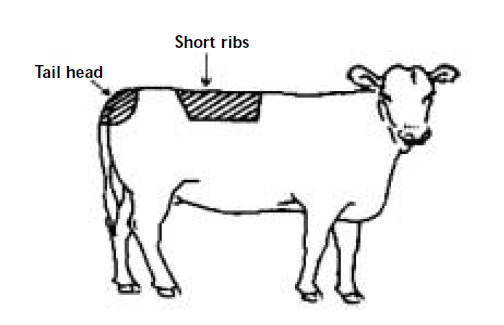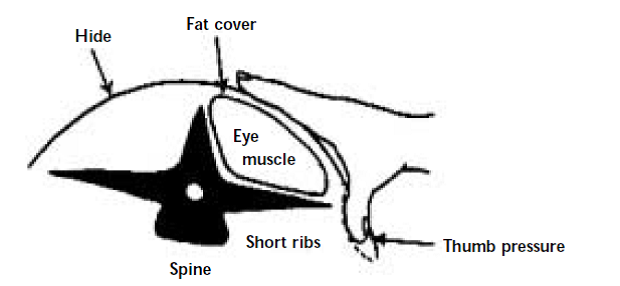5.02 - Condition scoring beef cattle
The body fat reserves of beef cattle are important at critical stages of the production cycle. At the beginning of winter they influence the amount of feed required to ensure satisfactory reproductive performance. The objective of condition scoring is to obtain a simple and reliable estimate of the body fat reserves of live cattle. The condition score provides an estimate of fat reserves that is independent of size and is a more reliable descriptor than liveweight alone.
Condition scoring can aid cattle management in two ways.
- Breeding cows: assessment of body condition at critical stages of the production cycle identifies those cows in need of nutritional management to reach target condition scores.
- Fattening animals: knowing the condition of fattening cattle allows selection of those with the desired level of fat cover for target markets (see Module 7: Meeting market specifications).
Target condition scores for cows:
- No lower than 2.5 at calving for autumn calving
- No lower than 2.5 at the start of mating for autumn calving
- No lower than 2.0 at calving for spring calving cows
Cows can be drafted at weaning on condition score so that preferential feeding can be given to those that may not achieve their target scores by calving.
Condition scoring techniques
The technique is easily learned and, although subjective, has been shown to give reliable results when related to subcutaneous fat cover. The method is a ‘hands-on’ system, where two areas of the animal's body are palpated to assess fat cover (see Figure 1). The two areas are:
- spinous processes or short ribs
- around the tail head.
The short ribs
The degree of prominence of the short ribs of the individual spinous processes, is found by placing the fingers flat over the short ribs and pressing the thumb into the end of the short ribs (see Figure 2). A condition score is given according to the ease with which the individual short ribs can be felt with the thumb.

Figure 1: The tail head and short ribs areas are palpated to assess fat cover
The tail head
The degree of fat cover around the tail head is assessed by using the fingers and thumb and should be done at the same time as assessing the short ribs. The appropriate score is given depending on the degree to which palpable fat can be felt.

Figure 2: The degree of fat cover around the tail head and short ribs is assessed using the fingers and thumb
The scores are described as follows:
- Emaciated.
- The individual processes are sharp to the touch, no tail head fat. The hip, bones and ribs are prominent.
- The individual processes can easily be felt, but feel rounded rather than sharp. There is some tissue cover around the tail head. Individual ribs are no longer visually obvious.
- The short ribs can only be felt with firm thumb pressure. Areas either side of the tail head have fat cover which can be easily felt.
- The processes cannot be felt and fat cover around the tail head is easily seen as slight mounds, soft to touch. Folds of fat are beginning to develop over ribs and thighs.
- The bone structure of the animal is no longer noticeable and the tail head is almost completely buried in fatty tissue.
The score can be varied half a score depending upon the amount of tail head fat, for example if the short rib palpation (using the thumb) gives score 4 but the tail head is a typical 3, the score would then be 3.5. Scores can be directly related to fatness at the P8 site.
